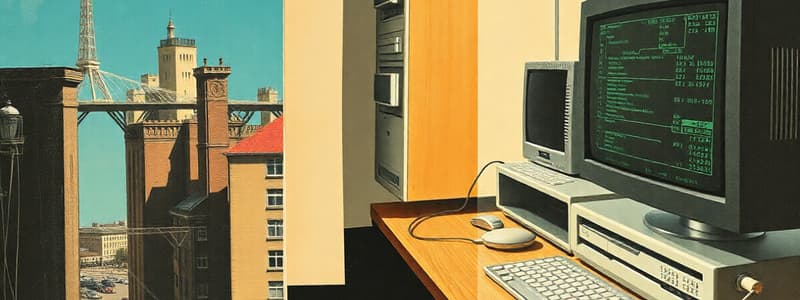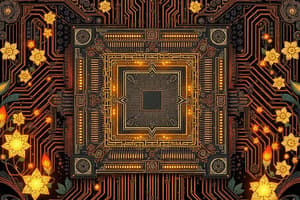Podcast
Questions and Answers
What is the primary function of input devices in a computer system?
What is the primary function of input devices in a computer system?
Why is memory considered crucial in a computer system?
Why is memory considered crucial in a computer system?
Which register specifies the address in memory for the next read or write operation?
Which register specifies the address in memory for the next read or write operation?
What role does the I/O buffer register (I/OBR) play in a computer system?
What role does the I/O buffer register (I/OBR) play in a computer system?
Signup and view all the answers
How does the CPU interact with memory during data processing?
How does the CPU interact with memory during data processing?
Signup and view all the answers
What is a key characteristic of the memory module in a computer?
What is a key characteristic of the memory module in a computer?
Signup and view all the answers
What does the I/O address register (I/OAR) do?
What does the I/O address register (I/OAR) do?
Signup and view all the answers
What is the primary function of a computer?
What is the primary function of a computer?
Signup and view all the answers
How does a program execution differ from simple data processing?
How does a program execution differ from simple data processing?
Signup and view all the answers
Which component of the computer is responsible for performing the actual execution of instructions?
Which component of the computer is responsible for performing the actual execution of instructions?
Signup and view all the answers
In the context of instruction processing, which of the following steps is performed first?
In the context of instruction processing, which of the following steps is performed first?
Signup and view all the answers
What is a primary purpose of interrupts in processing?
What is a primary purpose of interrupts in processing?
Signup and view all the answers
What does the Program Counter (PC) do in a computer system?
What does the Program Counter (PC) do in a computer system?
Signup and view all the answers
What problem can arise when the processor continually waits for an external device?
What problem can arise when the processor continually waits for an external device?
Signup and view all the answers
Which of the following registers temporarily holds data being transferred to or from memory?
Which of the following registers temporarily holds data being transferred to or from memory?
Signup and view all the answers
Which of the following describes the first step of the I/O program as mentioned?
Which of the following describes the first step of the I/O program as mentioned?
Signup and view all the answers
How does program execution proceed in a computer system?
How does program execution proceed in a computer system?
Signup and view all the answers
What is the function of the Instruction Register (IR)?
What is the function of the Instruction Register (IR)?
Signup and view all the answers
What does the term 'WRITE calls' refer to in this context?
What does the term 'WRITE calls' refer to in this context?
Signup and view all the answers
What is the value loaded into the instruction register (IR) during the first fetch cycle?
What is the value loaded into the instruction register (IR) during the first fetch cycle?
Signup and view all the answers
What is a consequence of issuing an I/O command without using interrupts?
What is a consequence of issuing an I/O command without using interrupts?
Signup and view all the answers
Which component is essential for transferring data between different parts of the computer system?
Which component is essential for transferring data between different parts of the computer system?
Signup and view all the answers
Which part of the instruction in the IR indicates that the accumulator (AC) is to be loaded?
Which part of the instruction in the IR indicates that the accumulator (AC) is to be loaded?
Signup and view all the answers
How many instruction cycles are needed to add the contents of memory locations 940 and 941?
How many instruction cycles are needed to add the contents of memory locations 940 and 941?
Signup and view all the answers
Which of the following could describe a processor that requires fewer cycles for executing complex instructions?
Which of the following could describe a processor that requires fewer cycles for executing complex instructions?
Signup and view all the answers
In the instruction expressed as ADD B,A in the PDP-11 processor, what is the final storage location of the result?
In the instruction expressed as ADD B,A in the PDP-11 processor, what is the final storage location of the result?
Signup and view all the answers
Why must the processor have at least two registers when executing the ADD instruction in the PDP-11?
Why must the processor have at least two registers when executing the ADD instruction in the PDP-11?
Signup and view all the answers
What happens during the execution cycle after the first instruction is fetched?
What happens during the execution cycle after the first instruction is fetched?
Signup and view all the answers
What is an example of an I/O operation mentioned for complex instructions?
What is an example of an I/O operation mentioned for complex instructions?
Signup and view all the answers
What happens when an interrupt occurs during the execution of a program?
What happens when an interrupt occurs during the execution of a program?
Signup and view all the answers
In the interrupt cycle, what does the processor check first?
In the interrupt cycle, what does the processor check first?
Signup and view all the answers
What does the processor do with the program counter during an interrupt?
What does the processor do with the program counter during an interrupt?
Signup and view all the answers
What is referred to as 'saving the context' in the process of handling an interrupt?
What is referred to as 'saving the context' in the process of handling an interrupt?
Signup and view all the answers
What indicates to the processor that an interrupt signal is present?
What indicates to the processor that an interrupt signal is present?
Signup and view all the answers
What is the state of interrupts during the process of checking for pending interrupts?
What is the state of interrupts during the process of checking for pending interrupts?
Signup and view all the answers
During the fetch cycle after an interrupt has been processed, what does the processor do next?
During the fetch cycle after an interrupt has been processed, what does the processor do next?
Signup and view all the answers
What happens if no interrupts are pending during the interrupt cycle?
What happens if no interrupts are pending during the interrupt cycle?
Signup and view all the answers
What is the primary purpose of the Interrupt Acknowledge command?
What is the primary purpose of the Interrupt Acknowledge command?
Signup and view all the answers
Which command is used to transfer data between the initiator and an I/O controller?
Which command is used to transfer data between the initiator and an I/O controller?
Signup and view all the answers
What does the Memory Write and Invalidate command guarantee?
What does the Memory Write and Invalidate command guarantee?
Signup and view all the answers
In the context of PCI commands, what is a Special Cycle used for?
In the context of PCI commands, what is a Special Cycle used for?
Signup and view all the answers
How do Memory Read commands primarily transfer data?
How do Memory Read commands primarily transfer data?
Signup and view all the answers
What is indicated by the byte enable lines during the Interrupt Acknowledge command?
What is indicated by the byte enable lines during the Interrupt Acknowledge command?
Signup and view all the answers
Which command enables a master to update configuration parameters in PCI devices?
Which command enables a master to update configuration parameters in PCI devices?
Signup and view all the answers
Which of the following commands is specifically designed for reading a burst of data?
Which of the following commands is specifically designed for reading a burst of data?
Signup and view all the answers
Study Notes
Chapter 3: A Top-Level View of Computer Function and Interconnection
- Computer components include the processor, main memory, and I/O modules, interconnected to execute programs
- Instruction cycle involves fetching instructions, operands, storing operands, and interrupt checks (if enabled)
- Key bus design elements include arbitration (centralized or distributed permission to send signals), timing (synchronized to a clock or asynchronous), and width (address and data lines)
3.1 Computer Components
- Von Neumann architecture is the foundation for virtually all contemporary computer designs, based on three key concepts
- Data and instructions are stored in a single, addressable memory
- Execution occurs sequentially (unless explicitly modified)
- Programs are stored in the same memory location as data
3.2 Computer Function
- Computer function is primarily program execution, which consists of a sequence of instructions stored in memory that the processor executes
- Instruction cycle involves fetch and execute cycles, with
- Processor-memory transfers (data movement)
- Processor-I/O transfers (data exchange with external devices)
- Data processing (arithmetic/logical operations)
- Control (changing the flow of execution)
- Instruction cycle includes:
- Instruction fetch: Fetching instruction from memory into the instruction register (IR)
- Instruction decoding (interpreting opcode): determining the type of operation and operands
- Operand address calculation (if necessary): Locating the operands in memory or I/O
- Operand fetch: Retrieving the operands from memory or I/O
- Data operation (performing the operation): Doing the specified computation
- Operand store (writing the result): Storing the result to memory or I/O
- Interrupts: An external event that can suspend the current program’s execution
3.3 Interconnection Structures
- Interconnection structures connect computer components (processor, memory, I/O)
- Communication pathways allow for data and control signals exchange between modules
- Bus structures (e.g., system bus, expansion buses) facilitate efficient data exchange, composed of data lines, address lines, and control lines
- Bus characteristics
- Type (dedicated or multiplexed)
- Arbitration method (centralized or distributed)
- Timing (synchronous or asynchronous)
- Width (data and address lines)
- Data transfer types
3.4 Bus Interconnection
- Bus is a shared communication pathway
- Buses consist of multiple lines for parallel data transmission
- Functional bus components include:
- Data lines: To transfer data between modules
- Address lines: To specify the source or destination of data on the data bus
- Control lines: To control the bus access mechanisms and operations
3.5 PCI (Peripheral Component Interconnect)
- PCI is a high-bandwidth, processor-independent bus
- PCI structure facilitates high-speed I/O operations
- PCI bus structure: System pins (like clock and reset), address and data pins, interface control pins, arbitration mechanisms, and other specialized signal lines
- PCI Commands
- Interrupt Acknowledge
- Special Cycle
- I/O Read and Write
- Memory Read and Write
- Configuration Read and Write
3.6 Recommended Reading and Web Sites
- Recommended reading and web resources for further study on PCI bus specifications and details
3.7 Key Terms, Review Questions, and Problems
- Key terms related to computer components and their interconnection
- Review questions related to the material for practice
- Problems for practical application
Studying That Suits You
Use AI to generate personalized quizzes and flashcards to suit your learning preferences.
Related Documents
Description
Test your knowledge on the essential functions and components of computer architecture. This quiz covers key concepts such as input devices, memory functions, registers, and the role of the CPU in processing data. Ideal for students eager to understand the basic principles of how computers operate.




